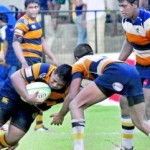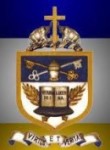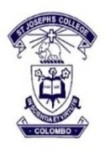By: Stewart Schneider-Loos (SPC Rugby 1983 – 1984). Courtesy: Sunday Leader.
 Although it was over 30 years ago, it seems like only yesterday…With the current schools rugby season in full swing, I would like to take you back thirty odd-years to reminisce about the Peterite team of 1984.
Although it was over 30 years ago, it seems like only yesterday…With the current schools rugby season in full swing, I would like to take you back thirty odd-years to reminisce about the Peterite team of 1984.
That year we did not win a championship, but I can assure you that the blokes that made up the side were a bunch of champions who played with pride and passion.
The pre-season commenced with the commanding Frank Hubert (better known as Frankie to most) in charge as head coach. It was in fact his second season as head coach since the demise of the legendary Archibald Perera. Frankie had been assisting Archie since leaving college in 1975.
Unfortunately for college, it was also to be his last season, as Frankie took up a job overseas the following year. His support team was made up of Orville Fernando, the well-known Peterite and former Havies and Sri Lanka forward and until last week the head of the Referees Society, as well as Shanaka Abeywickrema, the former Peterite hooker.
The late Austin Fernando made up the other part of the team management as Master in Charge of Sport at college. We had Nigel Forbes of the present Rugby Foundation fame, shaping up as the captain and number eight for the season. Unfortunately, the ministry of education overruled on his eligibility to participate in the schools season that year. However, Nigel went on to represent Havelock’s Sports club at division one club rugby later that year.
Many players vying for a position in the 1st fifteen that year had been inducted into rugby by the legend himself, Archibald Perera, be it at the junior level or as a player in the second fifteen squads of prior years. Rugby was everything to us; we literary ate, drank and slept rugby.
Many of us, in what was the last of the “English Medium” attended school, just so that we could play rugby. Thanks to Frankie, we were also fed a good diet of Peterite rugby history, culture and heritage. He would always relate stories of previous greats, and their exploits on the rugby field. Frankie was an encyclopaedia on Peterite rugby.
The season started with the usual early morning sessions, the road runs, which took us past the Bambalapitiya flats, as well as the house of the famous “De Silva’s” down Laurie’s road. Frankie, as coach was a strict disciplinarian, and took fitness training very seriously. Some of the fitness sessions were absolute torture, with blokes actually throwing up. Frankie, who was also the leading SLRFU referee at the time, spent a lot of time teaching us the rules of the game. He instilled in us the importance of understanding the laws of the game and that we needed to abide by them to the letter.
By the time the first game of the season came around, Viraj Fernando was appointed captain of the team. He was one of the few coloursmen in the team and was playing in his favourite position of fly half. Viraj was an easy going and a likeable chap who was able to rally the team around him. He also had a reputation as a good basketball player.Viraj is now domiciled in Toronto, Cananda.
That year, the 1st XV squad was made up of the following players.
Our front row was made up of Props, Illanguwan Dharamalingham and Baguwan Mohinani. Stewart Loos was the Hooker and substituted as a prop when required. We had Mohamed Misverdeen (who represented Sri Lanka at the under 24’s, Captained the University of Colombo and also represented the CH&FC) and Sampath Gomez (the night driver) in the second row. The back row was manned by the crack “spoiler” Chrishan Fernando, Balkan Rayen (Brother of former Peterite, Havies and Sri Lanka wing forward Hubert Rayen) and fast breaking Dave Croon. My position was always under pressure from Niranjan “Kitty” Wimalasena, the younger brother of “Pussa” PrasannaWimalasena. We had Kevin Rasquinho, the one tackle wonder who was a utility player that could fill in any position. Nilantha Silva was also a reserve that came on and made an impact during that season. Young Ramsey Decker was the replacement number 8 and Nilantha Pullenayagam, a strong wing forward
The scrumhalves position was shared that season by Colin Franke, and the naturally talented athlete in late Rowan Gunasekera. Viraj Fernando was the fly half and inside centre at times. Rohan Paiva, a naturally gifted player, also manned fly half position. Jerome Brohier was the inside centre. The outside centre was Graham Raux, who incidentally was the only player in the 1st XV team of 1984 to go on and don the national colours. Tyronne Fernando was a handy outside when he ran on for college.
The wingers were Royce Buultjens, better known for his cricket and the record-breaking captain of 1985, Rajith Abeygunawardena. Crofton Joseph our ever-reliable place kicker was the fullback was also well known for his skills at hockey and soccer. Ravi Direkze also occupied the positions of fullback and or winger from time to time.
Our classroom, grade 12 English Commerce was located over the chapel, with full view of the Galle Road. During the season it was also considered the “war room” of the 1st fifteen rugby team. We would have players from other classes drop in for a chat. Many a discussion about how we were progressing, debates on who should play where as well as lots of strategy was drawn up in this room.
The names of some of the prominent players who featured in the opposition teams that year were:
St Thomas – Jeremy John, Asanga Seneviratne (Current President of the SLRFU), Graham Tissera
Royal – Sampath Agalawatte, Janaka Lenaduwa, Ajith Weeratunga, Chiro Nanayakkara, Ajith Gunasekera & Feroze Suhaib
Isipathana – Nizam Jamaldeen, Shabeen Siddik & SanathMartis (the previous Peterite and Sri Lanka Schools coach),
Trinity – Sivaji Subramanium, IkramOdayar, Dilakshan Ratwatte, Manoj Jayatissa, Roger Halangoda& Ravi Pillai
St Anthony’s – Priyantha Ekanayake (Former Kandy and Sri Lanka Skipper)
St Joseph’s – Michael Perera
SPC ended being runner’s up in the schools rugby sevens competition for the Philip Buultjens trophy. We lost to a star-studded team from Royal College in the final (five players from that Royal college team went on to play for the President cup winning CR & FC team that year). We beat St Thomas’s in the quarterfinals and Trinity College in the Semi final; this was sweet revenge for loss we experienced earlier in the season.
At the end of the 1984 season, even though St Peters was not as successful as some of the other schools, we had four players selected to represent the Colombo Schools team for the Gratiaen Cup. They were Rajith Abegunawardena, Illangoonwan Dharamalingm, Royce Buultjens and Stewart Loos. The late Jeffery de Jong refereed that match which was against the outstation schools. Our own Rohan Paiva captained the under 17’s Colombo Schools side for the Tyrell Muttiah Trophy, which included the late Rowan Gunasekera and Ramsey Decker.
To this day, being biased, we believe that the team of 84’ broke the hoodoo in Kandy. We believe that poor refereeing decisions stopped us in our tracks. Our team was the forerunner for Rajith Abeygunawardena’sall conquering side of 1985.
There are two games that were of significance to the team that season. The first was the encounter against St. Thomas’s. The Archibald Perera trophy was on offer for the second time. St Peters had lost it the previous year and we knew it was our duty to bring it back to Bambalapitya where it rightly belonged. In that game, we controlled the majority of the possession, but failed to convert possession to points. We also missed a vital conversion that cost us a win.
It was in that game that the Petes halves combination came of age. Rowan Gunersekera and Rohan Paiva were at their best. We won ball in the lineout’s and our scrums were solid. I won a couple of strikes against the feed off the more experienced Jeremy John. We had to settle for a draw.
This was not what we wanted, we wanted a win, and we were left disappointed and empty. We had let the great old man, Frankie and ourselves down.
The second was the encounter against Trinity at Bogambara. The Lions were a star-studded outfit, while the Petes were a confident team after the draw against St. Thomas’s the previous week. We opened scoring in the 15th minute when Rowan set the line in motion after we had won a scrum in the Lion’s 25’. Skipper and centre Viraj Fernando scored by the corner flag after Jerome Brohier had cut loose. The always-reliable Crofton Joseph missed the conversion. The Trinitians struggled to cope with the pressure unleashed by the Peterite forwards; Chrishan Fernando, Dave Croon, Mohamed Misverdeen and Balkan Rayen were outstanding. We lead 4 – Nil at half time.
The fierce battle continued in the second half. Trinity cut down the lead when they were awarded a questionable penalty eight minutes to the end of the match just after we lost our experienced flanker, Chrishan Fernando to injury. Nilantha Silva came on as replacement. We continued to defend the slim lead, whilst listening out for the long whistle. Our supporters were already celebrating the historic win. Had the referee lost his whistle?
At this point I was injured; however the referee would not allow a doctor on the field. The referee wanted play to go on. In semi darkness, and long past the fulltime mark, SivajiSubramaniam barged over to score the winning points for Trinity. It was a gut wrenching experience; one man had stolen the dream of ‘84! We had beaten the lions in their own den.
As a result of the poor refereeing in that game, Frank Hubert who was also the top SLRFU referee at that time resigned as a member of the SLRFU referees association. He did not want to be part of a group that involved biased referees. It was a real pity as Anton Benedict was down to referee both these key games, but was replaced by Tony Amit. It was ironic that Tony Amit would later go on to coach St. Peters at rugby.
Unfortunately, Frank Hubert would miss out on the opportunity to referee at the ASIAD in Japan later that year, due to his resignation. Frankie always believed in being fair and stood by his team. To this day he has no regrets for his actions.
Whilst many of the players have migrated to places such as Australia, New Zealand, Canada and the USA, strong friendships that were forged during that season have been maintained.From time to time, a few of us would meet when on vacation in Colombo and take the opportunity to exchange yarns and speak about the good old times. I am sure that the teams that have gone before us as well as those after would have had similar experiences.
The Peteriteteam of 84 was a great side; it was a year that we thoroughly enjoyed and one in which we built strong bonds. It was a year that would prepare us for the rest of our lives. I always wondered why they say; “Rugby is the game they play in heaven” I now know why.
To celebrate the 30th Anniversary of the Team of 84’ a reunion has been organised for the weekend commencing the 20th of June. Celebrations will begin in Colombo and culminate with a trip to Pallekalle to witness the SPC vs Trinity match. We have members of that team travelling back to Colombo from around the world to participate in the reunion.
Like this:
Like Loading...
 My interest in rugby was spurred on in my very early years by Ago Paiva as I lived close to his home. There was a fairly large green available to boys of my age and we were inspired by Ago to make the grade in rugby. For the record, Ago played both rugby and cricket for college and his halves combination with Mahes Rodrigo at the base of the scrum, was undoubtedly the best both the CR & FC and the Ceylon rugby teams had at the time. I was selected in the college rugby team in 1957 and it included Jayantha Fernando, Christie Marathalingam, Russell Duckworth, Desmond Dharmarajah, Brian Seneviratne and Adiel Anghie, who played dual roles of also being outstanding cricketers. We had a good reputation as a competitive side and we got the better of many schools that year, except Trinity College. As we knew, Trinity was last beaten years earlier by teams in which our legendary coach at the time, Archibald Perera, played.
My interest in rugby was spurred on in my very early years by Ago Paiva as I lived close to his home. There was a fairly large green available to boys of my age and we were inspired by Ago to make the grade in rugby. For the record, Ago played both rugby and cricket for college and his halves combination with Mahes Rodrigo at the base of the scrum, was undoubtedly the best both the CR & FC and the Ceylon rugby teams had at the time. I was selected in the college rugby team in 1957 and it included Jayantha Fernando, Christie Marathalingam, Russell Duckworth, Desmond Dharmarajah, Brian Seneviratne and Adiel Anghie, who played dual roles of also being outstanding cricketers. We had a good reputation as a competitive side and we got the better of many schools that year, except Trinity College. As we knew, Trinity was last beaten years earlier by teams in which our legendary coach at the time, Archibald Perera, played.




















